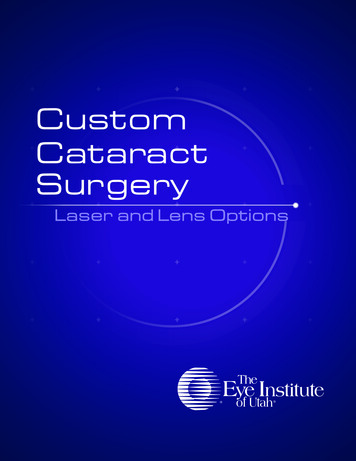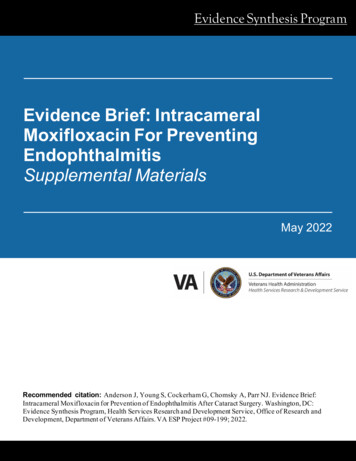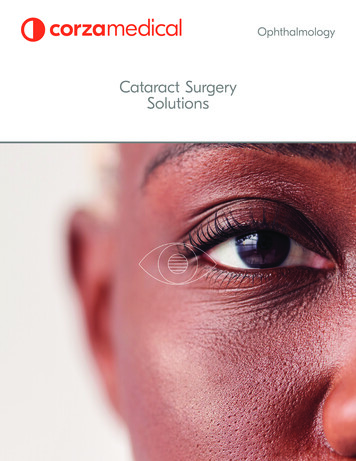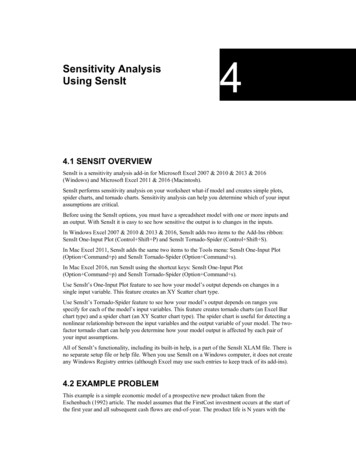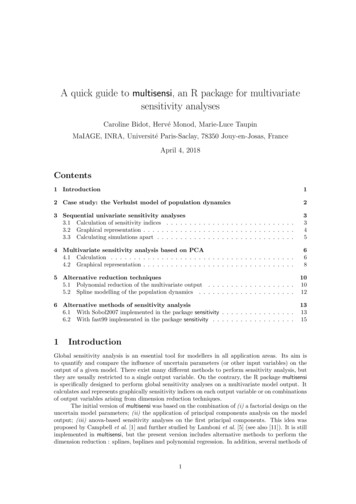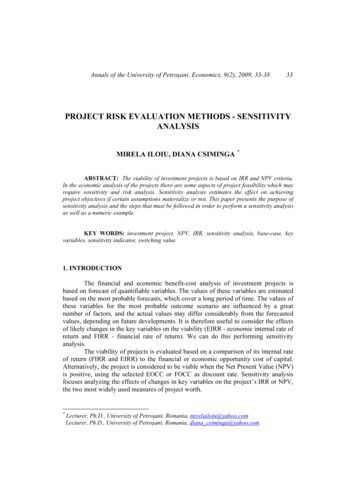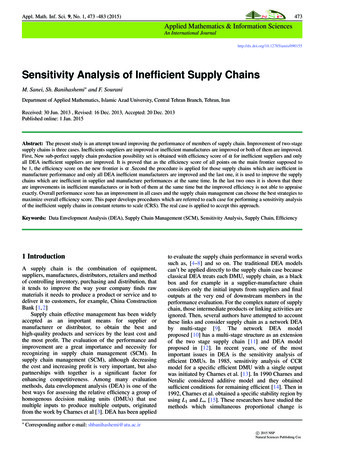
Transcription
Ophthalmol Clin N Am 19 (2006) 521–533Contrast Sensitivity and MeasuringCataract OutcomesMark Packer, MD*, I. Howard Fine, MD,Richard S. Hoffman, MDDepartment of Ophthalmology, Oregon Health and Sciences University, 1550 Oak Street,Suite 5, Eugene, OR 97401, USAFunctional vision means the ability of the visualsystem to receive, transmit, and report information. The optical system of the eye allows reception,whereas the neurosensory retina and the neuralpathways to the visual cortex govern transmission.Cortical elements in turn report information.Images form the elements of visual data. Theformation of the image on the retina depends onthe optical elements of the eye, including all of theocular media: the tear film, cornea, aqueoushumor, lens, and vitreous body. The principalelements in this system, the cornea and the lens, liewithin the province of the anterior segmentsurgeon or ophthalmologist who performs cataract and refractive surgery.The evaluation of functional vision in the clinicor laboratory may take a variety of approaches.Wavefront aberrometry, ray tracing, corneal topography, and double-pass devices enable oneobjectively to measure retinal image quality.Contrast-sensitivity testing, reading speed, anddriving simulations represent subjective tests thatmeasure the neural and the optical performance ofthe visual system. Both approaches add to theknowledge of functional vision.As the understanding of the visual system hasadvanced, the evaluation of surgical techniquesand devices has also evolved. Clinical studies havemeasured the outcomes of both corneal refractiveDrs. Packer and Fine are consultants for AdvancedMedical Optics and Bausch and Lomb.* Corresponding author.E-mail address: mpacker@finemd.com (M. Packer).surgery and lenticular surgery with the full armamentarium of functional vision testing. The results of ongoing research help to guide furtherdevelopments in these fields.Patients’ heightened expectations providea challenge for the increasing sophistication ofanterior segment surgeons. The methods used inclinical research today will likely become standards of clinical practice tomorrow. Thesemethods highlight the limitations of currentlyentrenched techniques, such as measurement ofSnellen acuity. Now the American NationalStandards Institute has adopted sine wave gratingcontrast sensitivity at five spatial frequencies andthe Early Treatment of Diabetic RetinopathyStudy logarithmic letter chart. Cataract and refractive surgeons should take notice of developments in visual science that will strongly affecttheir practices in the very near future.Although the achievement of 20/20 uncorrectedvisual acuity remains a laudable target for anycataract or refractive surgeon, the goal of highquality vision increasingly reflects the understanding of the visual system as a whole. In fact, Snellenacuity represents only a small portion of functionalvision. A comparison of vision and hearing highlights the limitations of standard visual acuity tests:the auditory equivalent of a standard high-contrastSnellen eye chart is a hearing test with only onehigh level of loudness for all sound frequencies.Today, contrast-sensitivity testing is emerging asa more comprehensive measure of vision that willprobably replace Snellen letter acuity testing, justas audiometric testing replaced the ‘‘click’’ andspoken-word tests used before World War II [1].0896-1549/06/ - see front matter Ó 2006 Elsevier Inc. All rights y.theclinics.com
522PACKEREngineers understand that Fourier analysisallows the representation of any visual object asa composite of sine waves of various frequencies,amplitudes, and orientations. In fact, visual processing in the human nervous system works likeFourier analysis in reverse, with functionallyindependent neural channels filtering images tocreate what is seen [2]. Sine wave gratings are thebuilding blocks of vision, just as pure tones are thebuilding blocks of audition.Ophthalmologists realize that patients maycomplain about haziness, glare, and poor nightvision despite 20/20 Snellen acuity. This anomalycan be understood when one realizes that theSnellen acuity letter recognition test uses very highcontrast. The jet black letters on the bright whitebackground have a great deal of reserve contrast,so that even a patient with severely reducedcontrast sensitivity can still read the chart. Thatpatient perceives the letters as gray on whiterather than black on white, but still is able torecognize them. The examiner has no way ofknowing just how gray the letters look to anyparticular patient. Snellen acuity is a relativelyinsensitive test of visual function.Contrast-sensitivity testing has the ability todetect differences in functional vision whenSnellen visual acuity measurements cannot [3].For example, a patient with loss of low-frequencycontrast sensitivity may be able to read 20/20 butbe unable to see a truck in the fog. Although blurcaused by refractive error alone affects only thehigher spatial frequencies, scatter of light causedby corneal or lenticular opacities causes loss atall frequencies. Glaucoma and other optic neuropathies generally produce loss in the middle andlow frequencies. Contrast sensitivity testing offerscritical information to help elucidate patients’diagnoses.Numerous studies have demonstrated the relationship of contrast sensitivity and visual performance. From driving difficulty [4] and crashinvolvement [5], to falls [6] and postural stabilityin the elderly [7], to activities of daily living andvisual impairment [8], to the performance of pilotsin aircraft simulators [9], contrast sensitivity hasconsistently been found to provide a high degreeof correlation with visual performance.Contrast sensitivity declines becauseof increasing aberrationsUnfortunately, contrast sensitivity declineswith age even in the absence of ocular pathology,et alsuch as cataract, glaucoma, or macular degeneration (Fig. 1). The pathogenesis of this decline invision likely involves changes in the spherical aberration of the crystalline lens.Spherical aberration is a property of sphericallenses. A spherical lens does not refract all parallelrays of incoming light to a single focal point. The lensbends peripheral rays more strongly so that these rayscross the optical axis in front of the paraxial rays. Asthe aperture of the lens increases the average focalpoint moves toward the lens, so that a larger pupilproduces greater spherical aberration.Spherical aberration of the cornea changeslittle with age. Total wavefront aberration of theeye increases more than threefold, however, between 20 and 70 years of age [10]. Wavefront aberration measurements combined with data fromcorneal topography demonstrate that the opticalcharacteristics of the youthful crystalline lenscompensate for aberrations in the cornea, reducing total aberration in younger people. Unfortunately, the aging lens loses its balance with thecornea, because both the magnitude and the signof its spherical aberration change significantly[11]. A loss of balance between corneal and lenticular spherical aberration causes the degradationof optical quality in the aging eye.The sine wave grating contrast sensitivity ofa pseudophakic patient with a spherical intraocular lens (IOL) implanted is no better than that ofFig. 1. Contrast sensitivity in five age groups 3 cd/m2.The decline in contrast sensitivity with age was demonstrated in a multicenter study of healthy normal subjects.(From Packer M. Contrast sensitivity in healthy subjects20 to 69 years old. Presented at the Symposium on Cataract, IOL and Refractive Surgery, American Society ofCataract and Refractive Surgery. San Francisco, April12, 2003; with permission.)
CONTRAST SENSITIVITY, MEASURING CATARACT OUTCOMESa phakic patient of a similar age who has nocataract [12]. When a 65-year-old patient with cataracts has the cataracts removed and is implantedwith spherical IOLs the resulting visual outcomeis no better than the visual quality of a 65-yearold without cataracts (Fig. 2). The fact that the visual quality of the IOL patients is no better thanthat of their same-age counterparts may seem surprising because an IOL is optically superior to thenatural crystalline lens. This paradox is explained,however, when one realizes that the intraocularimplant has positive spherical aberration likethe aging lens. It is not the optical quality of theIOL in isolation that creates the image, but theoptical quality of the IOL in conjunction withthe optical quality of the cornea.The spherical aberration of a manufacturedspherical IOL is in no better balance with thecornea than the spherical aberration of the agingcrystalline lens. Aberrations cause incoming lightthat is otherwise focused to a point to be blurred,which in turn causes a reduction in visual quality.This reduction in quality is more severe under lowluminance conditions because ocular aberrationsincrease when the pupil size gets larger.Pseudophakic correction of spherical aberrationThe youthful, emmetropic, minimally (or perhaps optimally) aberrated eye [13] has become thestandard by which the results of cataract and refractive surgery are evaluated. The erosion of accommodation and the decline in functionalvision that occurs with age [14] have both beenlinked to changes in the human lens [15,16].Lens replacement surgery offers a natural avenuefor the correction of presbyopia, and for the523reversal of increasing lenticular spherical aberration. Because the optical wavefront of the cornearemains essentially stable throughout life [17], refractive lens exchange seems to represent a permanent solution to the challenges of restoringaccommodation and achieving youthful qualityof vision. For these reasons the lens has startedto come into its own as the primary locus for refractive surgery.Recent advances in aspheric monofocal lensdesign also lend themselves to improvements inmultifocal and accommodative IOLs. Because thepositive spherical aberration of a spherical pseudophakic IOL tends to increase total opticalaberrations, attention has turned to the development of aspheric IOLs [18]. These designs are intended to reduce or eliminate the sphericalaberration of the eye, improve modulation transfer function as compared with a spherical pseudophakic implant, and enhance functional vision.A variety of aspheric IOL designs are currentlymarketed in the United States: the Tecnis Z9000IOL (Advanced Medical Optics, Santa Ana, California); the AcrySof IQ IOL (Alcon, Ft. Worth,Texas); and the SofPort AO IOL (Bausch andLomb, San Dimas, California).The Tecnis IOL was designed with a modifiedprolate anterior surface to compensate for theaverage corneal spherical aberration found in theadult eye. It shares basic design features withthe CeeOn 911A IOL, including a 6-mm biconvexsquare edge optic and angulated ‘‘capsular C’’polyvinylidene fluoride haptics. The Tecnis Z9000is a multipiece lens. It is available in both secondgeneration silicone and acrylic. The silicone IOLhas a refractive index of 1.46, and the acrylic lenshas a refractive index of 1.47. It introduces 0.27 mFig. 2. Contrast-sensitivity function with 4-mm pupil. The contrast sensitivity of pseudophakic patients with sphericalIOLs is no better than the contrast sensitivity of age-matched control subjects without cataract. (From Nio YK, Jansonius NM, Fidler V, et al. Spherical and irregular aberrations are important for the optimal performance of the humaneye. Ophthalmic Physiol Opt 2002;22:103–12; with permission.)
524PACKERof spherical aberration to the eye. The clinicalinvestigation of the Tecnis IOL submitted to theUS Food and Drug Administration (FDA) demonstrated elimination of mean spherical aberrationand significant improvement in functional visionwhen compared with a standard spherical IOL [19].The US Centers for Medicare and Medicaid Services announced New Technology IOL Status forthe Tecnis IOL on January 26, 2006 [20]:‘‘Today’s announcement of coverage with additional payment for an innovative type of intraocular lens reflects Medicare’s attention toimproved clinical benefits,’’ said CMS Administrator, Mark McClellan, MD, PhD. ‘‘For theselenses, there is clear evidence of improved functional vision and contrast acuity.’’The AcrySof IQ shares the UV and blue light–filtering chromophores found in the single-pieceacrylic AcrySof Natural IOL. The special featureof this IOL is the posterior aspheric surfacedesigned to compensate for spherical aberrationby addressing the effects of overrefraction at theperiphery. The AcrySof IQ is a single-piece lensmade of hydrophobic acrylic, and it has a refractive index of 1.55. It adds 0.20 m of sphericalaberration to the eye.The SofPort Advanced Optics (LI61AO) IOLis an aspheric IOL that has been specificallydesigned with zero spherical aberration so that itdoes not contribute to any pre-existing higherorder aberrations. It is a foldable silicone IOLwith polymethyl methacrylate haptics and squareedges, and it was specifically designed for use withthe Bausch and Lomb SofPort System, an integrated, single-use, single-handed planar deliveryIOL insertion system. The SofPort lens is a multipiece lens made of second-generation silicone. Ithas a refractive index of 1.43, and it introduces nospherical aberration to the eye.Peer-reviewed, prospective, randomized scientific publications have demonstrated reduction ofspherical aberration and excellent contrast sensitivity and contrast acuity with the Tecnis modified prolate IOL when compared with a varietyof spherical IOLs (as of this writing there are nopeer-reviewed publications evaluating clinical results with either of the other two aspheric IOLsavailable in the United States) [21–28].Mester [29] compared the quality of vision obtained with the Tecnis IOL and a spherical silicone IOL (SI 40, Advanced Medical Optics,Santa Ana, California). A total of 45 patientswere enrolled and randomized to receive theet alTecnis IOL in one eye and the SI 40 in the felloweye. The average photopic contrast-sensitivityvalues demonstrated a statistically significant advantage for the Tecnis IOL at all spatial frequencies (Fig. 3). The contrast-sensitivity curves showan even greater difference under mesopic conditions (Fig. 4), an expected result caused by thelarger pupil size and consequent greater contribution from spherical aberration in dim light.A comparison of corneal and total ocular aberrations demonstrates the improved wavefront of theeye with the Tecnis Z9000 IOL (Fig. 5). This improvement in total aberrations demonstrates thecritical compensatory relationship of cornea andlens in reducing spherical aberration.Packer and coworkers [30] compared peakcontrast sensitivity in healthy, normal eyes, stratified by age of patient, with eyes implanted witheither the Tecnis IOL or an acrylic sphericalIOL (AR40e, Advanced Medical Optics, SantaAna, California). They reported that mesopic contrast sensitivity declined with age. Among 69 eyesof 36 patients, ranging in age from 21 to 61, theyfound mean peak mesopic contrast sensitivity atthree cycles per degree of 72.4 units for the 20 to30 year olds, whereas subjects aged 30 to 50 yearsdemonstrated mean peak mesopic contrast sensitivity of 51.9 units. Ten eyes implanted with theTecnis IOL in patients of average age 69.5 yearsachieved mean peak mesopic contrast sensitivityat three cycles per degree of 83.8, better than the20 to 30 year old group. Meanwhile, 11 eyes implanted with the control IOL in patients of average age 69.4 years demonstrated mean peakmesopic contrast sensitivity at three cycles perFig. 3. Photopic contrast sensitivity of subjects implanted with the Tecnis Z9000 and SI40 IOLs. (FromMester U. Improved optical and visual quality withaspheric IOL. Presented at the American Society of Cataract and Refractive Surgery Symposium. Philadelphia,June 2, 2002; with permission.)
CONTRAST SENSITIVITY, MEASURING CATARACT OUTCOMESFig. 4. Mesopic contrast sensitivity of subjects implanted with the Tecnis Z9000 and SI40 IOLs. (FromMester U. Improved optical and visual quality withaspheric IOL. Presented at the American Society of Cataract and Refractive Surgery Symposium. Philadelphia,June 2, 2002; with permission.)degree of 47.1, worse than the 30 to 50 year oldage group (Fig. 6).The results of peer-reviewed publications onthe Tecnis IOL are summarized in Table 1. Theweight of evidence demonstrating superior functional vision and contrast sensitivity with themodified prolate IOL has continued to grow.That the pseudophakic elimination of sphericalaberration reverses the age-related decline in contrast sensitivity confirms the hypothesis that decreased functional vision results primarily fromaging changes in the human lens.The effect of tilt and decentration onwavefront-corrected intraocular lensesOptical laboratory studies have cast doubt onthe efficacy of aspheric IOLs with negative525Fig. 6. Peak mesopic contrast sensitivity of subjects implanted with the Tecnis IOL is higher than that ofhealthy, normal subjects in their twenties. (From PackerM, Fine IH, Hoffman RS. Quality of vision with a modified anterior prolate aspheric intraocular lens. Presentedat the European Society of Cataract and Refractive Surgery Symposium. Nice, France, September 11, 2002;with permission.)spherical aberration, such as the Tecnis andAcrySof IQ, because of the range of tilt anddecentration of pseudophakic lenses in general[31,32]. The eye model used to design the TecnisIOL assumed a rotationally symmetric cornea reflecting the mean spherical aberration in a population of patients presenting for cataract surgery[18]. This model assumed monochromatic lightand a symmetric cornea. Criticism of the modelsuggested, however, that it oversimplified the actual effects of the wavefront-corrected IOL by ignoring the contributions of polychromatic lightand the implications of asymmetric corneal aberrations, such as coma [33].Fig. 5. Photopic and mesopic contrast sensitivity of subjects implanted with the Tecnis Z9000 and SI40 IOLs. (FromMester U. Improved optical and visual quality with aspheric IOL. Presented at the American Society of Cataract andRefractive Surgery Symposium. Philadelphia, June 2, 2002; with permission.)
526Table 1Results of peer-reviewed publications on Tecnis IOLDateComparator IOLs: study designResultsMesterJ Cataract Refract Surg2003SI40; intraindividual study; 37patientsSpherical aberration in Tecnis eyes notsignificantly different from zero.Significantly better low-contrast visual acuity atall chart contrast levels after 3 monthspostoperatively.Significantly better contrast sensitivityunder photopic conditions at all spatialfrequencies at 3 months postoperatively.Significantly better contrast sensitivity undermesopic conditions at all frequenciesat 3 months postoperatively.PackerJ Cataract Refract Surg2004AR40e; interindividual study;30 patientsAfter monocular comparison: at 3 monthspostoperatively, significantly bettercontrast sensitivity under photopicconditions at 6 cpd and under mesopicconditions at 1.5 and 3 cpd.After bilateral comparison: significantly bettercontrast sensitivity under photopic conditionsat 3 and 6 cpd and under mesopic conditionsat 1.5, 3, and 6 cpd.KershnerJ Cataract Refract Surg2003Silicone plate-haptic andsingle-piece acrylic; 221 eyesof 156 patientsCompared with other lens, significantlygreater improvement in postoperativecontrast sensitivity over preoperativevalues under photopic conditions withoutglare at 1.5, 6, and 12 cpd.Enhanced retinal image contrast.BellucciJ Refract Surg2004911A; SA60AT; MA60BM;AR40e; interindividualstudy; 25 eyes of 25 patientsLower total ocular spherical aberrationat 4-mm and 6-mm optical zonescompared with other IOLs in study.Lower myopic refractive shift with mydriasis.RicciArch Ophthalmol Scand2004911A; intraindividual study; 12patientsSignificantly better low-contrast photopicvisual acuity for all contrast levels testedexcept 100%, with mydriasiset alJournalPACKERAuthor
Bull Soc Belge Ophthalmol2004AR40e; SN60AT;interindividual study; 98 eyesof 71 patients randomlyreceived one of the threelensesCompared with the AR40e, significantly bettercontrast sensitivity at 3 and 12 cpd underphotopic conditions without glare; at3, 12, and 18 cpd under photopic conditionswith glare; at 1.5, 12, and 18 cpd undermesopic conditions without glare; and at12 and 18 cpd under mesopic conditionswith glare.Compared with the SN60AT, significantlybetter contrast sensitivity at 19 of 20 spatialfrequencies tested (photopic and mesopicconditions with and without glare).BellucciJ Cataract Refract Surg2005CaspriniActa Ophthalmol Scand2005SA60AT; interindividualstudy; 60 eyes of 60 patientsrandomly received onetype of lensMA30BA; AR40; SA30AL;AR40e; interindividualstudy; 175 patients randomlyreceived one type of lensSignificantly better contrast sensitivity forspatial frequencies higher than 1.5 cpdunder both photopic and mesopicconditions.Statistically significant difference in mean spherical aberration coefficient (Z4.0) of the wholeeye for a 5-mm pupil between the SA30AL,AR40e, and Tecnis groups, and the MA30BAgroup.Compared with the other IOLs, a lowerpercentage of patients experienced photicphenomena while driving at night at2 months postoperatively.MartinezPalmerArch Soc Esp Oftalmol2005SA60AT; Inter-individual;bilateral implantation ofsame lens in 58 patientsSignificantly better monocular and binocularvisual acuity 3 months postoperatively.Better monocular and binocular mesopiccontrast sensitivity at 3 monthspostoperatively.CONTRAST SENSITIVITY, MEASURING CATARACT OUTCOMESKennisAbbreviation: cpd, cycles per degree.527
528PACKERIn fact, the eye model using monochromatic,symmetric optics does suggest tight tolerances fortilt and decentration of IOL correcting sphericalaberration. For example, the model eye used in theTecnis IOL design study demonstrates a toleranceof 0.4 mm decentration and 7-degree tilt for themodified prolate IOL with Z (4,0) ¼ 0.27 m [18].At this degree of decentration or tilt the 15 cycleper degree contrast ratio of the wavefront-correctedIOL with negative spherical aberration becomesequivalent to that of a standard spherical IOL.The reason that decentration reduces theoptical efficiency of an aspheric lens may beexplained by the induction of higher-order aberration, such as coma [34]. As an example, consideran aspheric IOL decentered 0.5 mm along the 180degree meridian for a 6-mm pupil. Given a coefficient of fourth-order spherical aberration in theIOL of 0.29 mm, then the coefficient of inducedthird-order horizontal coma is 0.30 mm.A meta-analysis of the peer-reviewed literatureon the subject of IOL tilt and decentration hasbeen performed to determine the approximatepercentage of pseudophakic eyes that may beexpected to reside within the tolerances set bythe reported Tecnis design eye model [35]. The selected studies required a complete, continuouscurvilinear capsulorrhexis and in-the-bag IOL fixation. Postoperative measurement of IOL positionwas measured using Scheimpflug photography,which measures along the visual axis. When asymmetric aberrations and polychromatic light aretaken into account, however, a newly developedmodel has suggested relatively relaxed tilt and decentration tolerances for wavefront-correctedet alIOLs. This model was developed using cornealwavefront data from patients presenting for cataract surgery, including both symmetric and asymmetric aberrations, and was subsequently verifiedwith these patients’ clinical postoperative data[33]. In the verification study, three surgeons randomly assigned a wavefront-corrected IOL to oneeye and a standard spherical IOL to the fellow eyeof 79 patients. The Zernike terms predicted by themodel for both the wavefront-corrected IOL andthe control IOL closely approximated the clinicalresults. In particular, this model very closelypredicted the Z (4,0) term for both the wavefrontcorrected and the control IOL. This validated eyemodel was then used to evaluate the effects of decentration and tilt on the modulation transferfunction of the wavefront-corrected IOL. Assuming polychromatic illumination and incorporatingthe effects of the clinically validated asymmetricaberrations, the degradation of modulation transfer function with decentration to the level of a control standard spherical IOL occurred at 0.8 mminstead of 0.4 mm as in the simplified, symmetriceye model. The degradation of modulation transferfunction with tilt to this level occurs at 10 degreesinstead of 7 degrees (Figs. 7 and 8).By analyzing the peer-reviewed literature ondecentration in terms of a tolerance of 0.8 mm, asdemonstrated by the clinically verified eye model,a significant reduction in the percentage of casesoutside of tolerance emerges. For example, thepercentage of eyes with a three-piece silicone IOLwith polymethyl methacrylate haptics decenteredgreater than 0.8 mm is expected to be 0.0001%(Table 2). The number of IOLs expected to tiltFig. 7. Average radial modulation transfer function (MTF) versus decentration. Assuming polychromatic illuminationand incorporating the effects of the clinically validated asymmetric aberrations, the degradation of MTF with decentrationto the level of a standard spherical IOL occurs at 0.8 mm instead of 0.4 mm as in the simplified, symmetric eye model.(From Packer M. Tilt and decentration: toward a new definition of tolerance. EyeWorld 2005;10:65–6; with permission.)
CONTRAST SENSITIVITY, MEASURING CATARACT OUTCOMES529Fig. 8. Average radial modulation transfer function (MTF) versus tilt. Assuming polychromatic illumination and incorporating the effects of the clinically validated asymmetric aberrations, the degradation of MTF with tilt occurs at 10degrees instead of 7 degrees as in the simplified, symmetric eye model. (From Packer M. Tilt and decentration: towarda new definition of tolerance. EyeWorld 2005;10:65–6; with permission.)Table 2Percentage of eyes with a decentration O0.8 mmaOverallOptic-haptic A 1 070.060.0002Abbreviations: PMMA, polymethyl methacrylate; PVDF, polyvlnylidene fluoride.aIn this analysis of the available peer-reviewed literature on decentration and tilt the means and standard deviationsfor each IOL design were used to calculate the percentage of IOLs expected to decenter more than 0.8 mm, the point atwhich the MTF of the modified prolate Tecnis IOL is equivalent to that of a standard spherical IOL. The analysis included the following reports:Akkin C, Ozler SA, Mentes J. Tilt and decentration of bag-fixated intraocular lenses: a comparative study betweencapsulorhexis and envelope techniques. Doc Ophthalmol 1994;87:199–209.Hayashi K, Harada M, Hayashi H, et al. Decentration and tilt of polymethyl methacrylate, silicone, and acrylic softintraocular lenses. Ophthalmology 1997;104:793–8.Kim JS, Shyn KH. Biometry of 3 types of intraocular lenses using Scheimpflug photography. J Cataract Refract Surg2001;27:533–6.Hayashi K, Hayashi H, Nakao F, et al. Comparison of decentration and tilt between one piece and three piece polymethyl methacrylate intraocular lenses. Br J Ophthalmol 1998;82:419–22.Mutlu FM, Bilge AH, Altinsoy HI, et al. The role of capsulotomy and intraocular lens type on tilt and decentrationof polymethylmethacrylate and foldable acrylic lenses. Ophthalmologica 1998;212:359–63.Hayashi K, Hayashi H, Nakao F, et al. Intraocular lens tilt and decentration after implantation in eyes with glaucoma. J Cataract Refract Surg 1999;25:1515–20.Wang MC, Woung LC, Hu CY, et al. Position of polymethyl methacrylate and silicone intraocular lenses after phacoemulsification. J Cataract Refract Surg 1998;24:1652–7.Hayashi K, Hayashi H, Nakao F, et al. Anterior capsule contraction and intraocular lens decentration and tilt afterhydrogel lens implantation. Br J Ophthalmol 2001;85:1294–7.Taketani F, Matuura T, Yukawa E, et al. Influence of intraocular lens tilt and decentration on wavefront aberrations. J Cataract Refract Surg 2004;30:2158–62.Dick HB, Schwenn O, Krummenauer F, et al. Refraction, anterior chamber depth, decentration and tilt after implantation of monofocal and multifocal silicone lenses. Ophthalmologe 2001;98:380–6.
530PACKER10 degrees or more is vanishingly small andinsignificant.If common levels of tilt and decentrationsignificantly affected the functioning of wavefront-corrected IOLs, it would be difficult toexplain the evidence of elimination of sphericalaberration and improved functional vision foundin multiple investigations of the Tecnis IOL. Thenew clinically validated eye model described byPiers and coworkers [33] helps relieve this potential paradox. Areas for future research includeverification of the decentration and tilt of thewavefront-corrected IOL itself.Customizing the correction of spherical aberrationAnother important consideration for the general applicability of aspheric IOLs involves therange of spherical aberration in the humancornea. In the design study of the Tecnis IOL, itwas determined that approximately 90% of thepatient population would demonstrate a benefitfrom implantation of the IOL [18]. The distribution of corneal spherical aberration found in thestudy population clustered around the meansuch that 10% of subjects would demonstrategreater absolute spherical aberration after implantation of the modified prolate IOL than theywould have demonstrated after implantation ofa spherical IOL. Additional data collection suggests that the proportion may in fact be closerto 4% of the population (Fig. 9). Regardless ofthe precise proportion of outliers, it is clear thatFig. 9. Distribution of corneal spherical aberrationvalues (N ¼ 202 patients). The Tecnis IOL was designedto correct the population mean corneal spherical aberration. A certain percentage of individuals to the left of themean are not expected to show a demonstrable benefitfrom implanta
Althoughtheachievementof20/20uncorrected visual acuity remains a laudable target for any cataract or refractive surgeon, the goal of high- quality vision increasingly reflects the understand- ing of the visual system as a whole. In fact, Snellen acuityrepresentsonlyasmallportionoffunctional vision.
